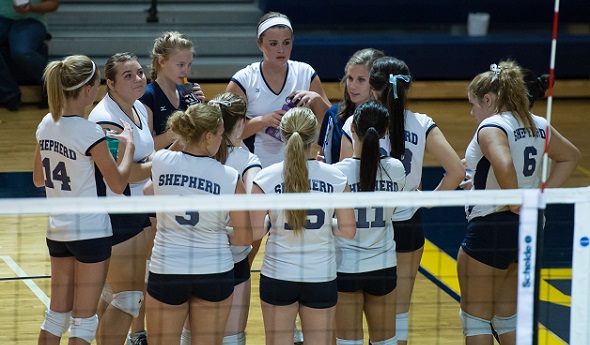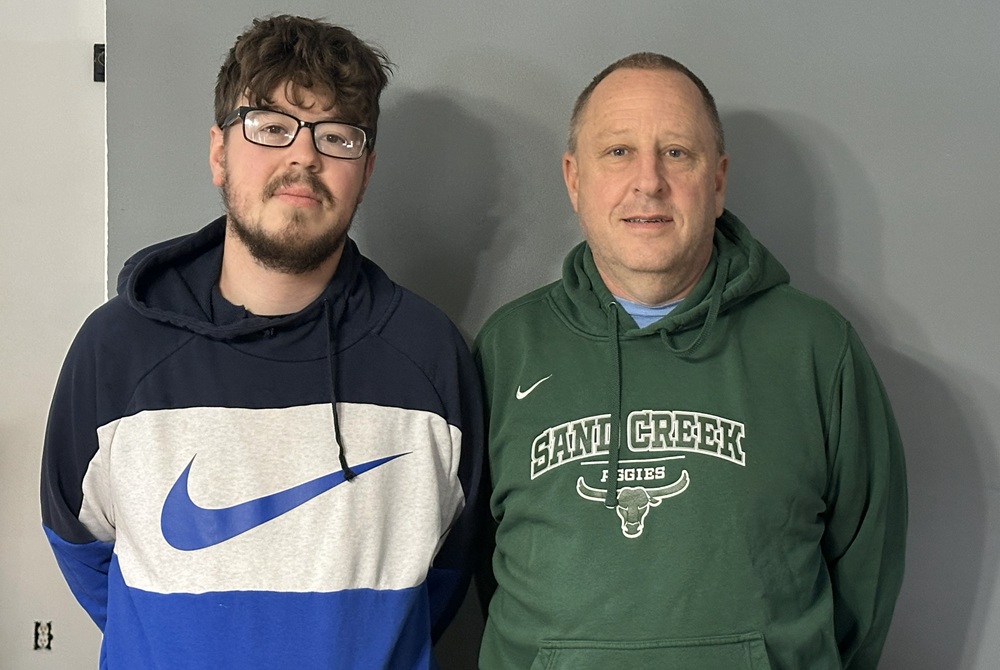
Using Heads in the Heat of Competition
December 20, 2013
By Rob Kaminski
MHSAA benchmarks editor
With so much recent attention to the risks and recognition of concussions in collision sports, athletic leaders have put their heads together to address far more common – but often overlooked – threats to the health of our student-athletes: heat and sudden cardiac arrest.
The No. 1 killer of young athletes is sudden cardiac arrest, while heat stroke victims can surpass that during the year’s hottest months. While the moment of impact leading to a concussion is totally unpredictable, athletic trainers, coaches and administrators have the ability to diminish the occurrences of cardiac arrest and heatstroke. Typically, there is a pre-existing condition, or family history suggesting probabilities for sudden cardiac arrest, which can be treated when detected. And, the perils associated with hot weather – heat stroke, prostration – are almost always completely preventable.
The MHSAA has addressed both issues recently. With assistance from numerous medical governing bodies, the annual pre-participation physical form was revamped and expanded prior to the 2011-12 school year to include comprehensive information regarding participants’ medical history.
In May, the Representative Council adopted a Model Policy for Managing Heat & Humidity (see below), a plan many schools have since adopted at the local level. The plan directs schools to monitor the heat index at an activity site once the air temperature reaches 80 degrees and provides recommendations when the heat index reaches certain levels, including ceasing activities when it rises above 104 degrees.
The topic of heat-related illnesses receives a lot of attention at the start of fall when deaths at the professional, collegiate and interscholastic levels of sport occur, especially since they are preventable in most cases with the proper precautions. In football, data from the National Federation of State High School Associations shows 41 high school players died from heat stroke between 1995 and 2012.
“We know now more than we ever have about when the risk is high and who is most at risk, and we’re now able to communicate that information better than ever before to administrators, coaches, athletes and parents," said Jack Roberts, executive director of the MHSAA. “Heat stroke is almost always preventable, and we encourage everyone to avail themselves of the information on our website.
“Schools need to be vigilant about providing water during practices, making sure that students are partaking of water and educating their teams about the need for good hydration practices.”
All of which is not to say concussions aren’t a serious matter; they are. In fact, leaders in sport safety can take advantage of the concussion spotlight to illuminate these additional health threats.
A recent New York Times story (May 2013) by Bill Pennington featured a February 2013 gathering in Washington organized by the National Athletic Trainers Association. In the article, Dr. Douglas J. Casa, professor of kinesiology at the University of Connecticut and Chief Operating Officer of the Korey Stringer Institute (founded in the late NFL offensive lineman’s name to promote prevention of sudden death in sport), suggests just that.
“All the talk about head injuries can be a gateway for telling people about the other things they need to know about, like cardiac events and heat illness,” said Casa in the article. “It doesn’t really matter how we get through to people as long as we continue to make sports safer.”
Education and prevention methods need to find a permanent place in school programs if those programs are to thrive and avoid becoming targets at which special interest groups can aim budgetary arrows.
Dr. Jonathan Drezner, the president of the American Medical Society for Sports Medicine, said in the New York Times piece that sudden cardiac arrest is “so incredibly tragic and stunning that people aren’t comfortable putting it into the everyday conversation. I do wish, to some extent, it was something people talked more about because we are getting to a place where we could prevent many of these deaths.”
When it comes to heat-related deaths or illnesses, the prevention efforts can be even more successful by educating the masses. And, these efforts can be done at minimal cost to schools.
“That’s the thing about curtailing exertional heat illness: it’s 100 percent preventable, and unlike other health threats to athletes, the solutions can be very low-tech and inexpensive,” said Dr. Michael F. Bergeron, the director of the National Institute for Athletic Health & Performance at the University of South Dakota’s Sanford Medical Center, in the New York Times story.
To assist with cost and data maintenance, the MHSAA has teamed with Sports Health to provide schools with psychrometers (heat measurement instruments) at a discounted rate, and has built online tools to track heat and humidity conditions.
Managing heat and humidity policy
- Thirty minutes prior to the start of an activity, and again 60 minutes after the start of that activity, take temperature and humidity readings at the site of the activity. Using a digital sling psychrometer is recommended. Record the readings in writing and maintain the information in files of school administration. Each school is to designate whose duties these are: generally the athletic director, head coach or certified athletic trainer.
- Factor the temperature and humidity into a Heat Index Calculator and Chart to determine the Heat Index. If a digital sling psychrometer is being used, the calculation is automatic.
If the Heat Index is below 95 degrees:
All Sports
- Provide ample amounts of water. This means that water should always be available and athletes should be able to take in as much water as they desire.
- Optional water breaks every 30 minutes for 10 minutes in duration.
- Ice-down towels for cooling.
- Watch/monitor athletes carefully for necessary action.
If the Heat Index is 95 degrees to 99 degrees:
All Sports
- Provide ample amounts of water. This means that water should always be available and athletes should be able to take in as much water as they desire.
- Optional water breaks every 30 minutes for 10 minutes in duration.
- Ice-down towels for cooling.
- Watch/monitor athletes carefully for necessary action.
Contact sports and activities with additional equipment:
- Helmets and other possible equipment removed while not involved in contact.
- Reduce time of outside activity. Consider postponing practice to later in the day.
- Recheck temperature and humidity every 30 minutes to monitor for increased Heat Index.
If the Heat Index is above 99 degrees to 104 degrees:
All Sports
- Provide ample amounts of water. This means that water should always be available and athletes should be able to take in as much water as they desire.
- Mandatory water breaks every 30 minutes for 10 minutes in duration.
- Ice-down towels for cooling.
- Watch/monitor athletes carefully for necessary action.
- Alter uniform by removing items if possible.
- Allow for changes to dry T-shirts and shorts.
- Reduce time of outside activity as well as indoor activity if air conditioning is unavailable.
- Postpone practice to later in the day.
Contact sports and activities with additional equipment
- Helmets and other possible equipment removed if not involved in contact or necessary for safety.
- If necessary for safety, suspend activity.
Recheck temperature and humidity every 30 minutes to monitor for increased Heat Index.
If the Heat Index is above 104 degrees:
All sports
- Stop all outside activity in practice and/or play, and stop all inside activity if air conditioning is unavailable.
Note: When the temperature is below 80 degrees there is no combination of heat and humidity that will result in need to curtail activity.
PHOTO: The Shepherd volleyball team includes hydration during a timeout in a match this fall.

Father & Son Set to Meet for 1st Time Coaching from Opposing Benches
By
Doug Donnelly
Special for MHSAA.com
December 10, 2025
The bantering back and forth is almost complete.
 On Thursday, Mike and Zachary Zyla will finally coach against each other in a varsity girls basketball game.
On Thursday, Mike and Zachary Zyla will finally coach against each other in a varsity girls basketball game.
It’s a game that both coaches circled months ago when Zachary, 26, got his first head coaching job at Britton Deerfield.
“It’s going to be intense,” Zachary said. “I’m sure he will want to win just as badly as I will. Me and our girls have been talking about the game a lot because it’s a game we think we can win. We want to beat Sand Creek.”
Mike Zyla coaches Sand Creek and is Zachary’s dad. He is a longtime coach in cross country and track and added varsity basketball to his resume three years ago. Zachary, who played at Sand Creek, was hired this past offseason to coach the Patriots.
Both schools are in the Tri-County Conference.
“It’s going to be fun,” Mike said. “We’ve been going back and forth about it for a couple of weeks. We’ll see how it goes.”
Basketball is special in the Zyla household.
Zachary’s other brother, Ryan, coaches at a junior college in Minnesota. His sister, Chelsi, played two years of college basketball after graduating from Sand Creek. Their mom, Kirsten, keeps the scorebook for Mike’s games. She is a special education teacher at Britton Deerfield.
“When basketball season rolls around, that’s all we talk about,” Zachary said.
“I guess it’s a little bit in the bloodlines,” Mike said.
After graduating from Sand Creek in 2018, Zachary served in the Navy. He returned home two years ago and served two seasons as his dad’s assistant.
“I just love the game of basketball,” he said. “I’ve been playing since I was probably 2 years old. It’s the thing I’m passionate about. I watch almost every night. If it’s not a live basketball game, I watch clips of old games. I’m just a junkie for basketball.”
Mike said he misses having his son on his bench.
“I miss having him on staff,” Mike said. “He’s really sharp, picking stuff up on the fly. It was nice having him on the sidelines with me. It’s a good opportunity for him, though.”
Please welcome BD’s new varsity girls basketball coach Zach Zyla! Zach comes to BD from Sand Creek where his father Mike is the head girls coach. Zach assisted on the Aggie varsity girls team in the 2024/25 season and is a track assistant coach for the Aggies. Go Patriots! pic.twitter.com/6cpwUw6OW4
— BD Athletics (@athletics_bd) May 2, 2025
Zachary accepted the job in time to have a summer program with BD.
“I’ve always been a big fan of basketball,” he said. “It’s in my blood. I started coaching the Sand Creek hoopsters when I was 16 years old. I knew that’s what I wanted to do. I would say coaching at the varsity level was a goal of mine. It’s always been a dream of mine. I didn’t expect to get a head coaching job so soon. I’d like to get to the next level someday.”
He said he has a few new things for his team to run against his dad.
“He taught me a lot, but our coaching strategies are different,” Zachary said. “I think I’m going to have some things he hasn’t seen yet.”
Sand Creek and BD both lost their season openers Tuesday. Since BD’s game started at 4:30 p.m., Zachary was able to get to Sand Creek to see his dad’s game against Pittsford.
“He was able to scout us,” Mike said.
It’s all in good fun.
“We have a great relationship,” Zachary said. “We bounce ideas off each other all of the time. Even for our first game of the season, we were talking about what we should do, the offenses and defenses. We talk pretty much every day.”
As rare as it is for a father and son to coach against each other, it’s the second time it’s happened in Lenawee County in recent years. Hudson varsity boys basketball coach Jeff Webster coached against his son, Jamison Webster, when Hudson played Tecumseh two seasons ago.
Jamison said it was a great experience, one the Zylas will never forget.
“Coaching and competing against my dad’s teams at Hudson over the last few years has been a great experience,” he said. “We both want to win, being the competitors we are. That being said, the lifelong memories we have made being able to share a sport we both love is what makes it special.”
Zachary said he knows it will be a little different than normal.
“The game’s intensity will be higher than most nights,” he said.
Mike agreed. He doesn’t relish the idea of beating his son, but doesn’t plan on backing down. Since they are both in the TCC, they’ll face off again later this winter.
“We’re both pretty competitive,” he said. “Competitive genes are in the family. I don’t think either one of us will be very happy if we are on the losing side Thursday night.”
 Doug Donnelly has served as a news and sports reporter at the Adrian Daily Telegram and the Monroe News for 30 years, including 10 years as city editor in Monroe. He's written a book on high school basketball in Monroe County and compiles record books for various schools in southeast Michigan. He is now publisher and editor of The Blissfield Advance, a weekly newspaper. E-mail him at [email protected] with story ideas for Jackson, Washtenaw, Hillsdale, Lenawee and Monroe counties.
Doug Donnelly has served as a news and sports reporter at the Adrian Daily Telegram and the Monroe News for 30 years, including 10 years as city editor in Monroe. He's written a book on high school basketball in Monroe County and compiles record books for various schools in southeast Michigan. He is now publisher and editor of The Blissfield Advance, a weekly newspaper. E-mail him at [email protected] with story ideas for Jackson, Washtenaw, Hillsdale, Lenawee and Monroe counties.
PHOTO Britton Deerfield varsity girls basketball coach Zachary Zyla poses for a photo with his father Mike Zyla, right, the varsity girls basketball coach at Sand Creek. (Photo provided by the Zyla family.)

